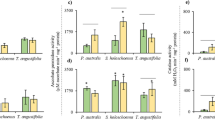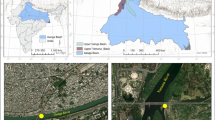Abstract
Damodar is an important river of the industrial state Jharkhand, India. It menders through various coal mining regions is now under serious threats due to industrial and sewage discharge which is rich in TOC, available nitrogen, phosphorus and potassium (primary nutrient plants). Hence, present research work was formulated with the hypothesis of “river sediment possess high concentration of primary nutrients which can be used in mine site reclamation”. In this regard, spatiotemporal and seasonal variations in concentration of these nutrients were studied to know its sources. Nutrient index of the sediment was assessed to compare its fertility with soil for its utilization in mine site reclamation and pollution control of the river. Study area has momentous spatial variation; Garga river (site 12) carry sewage and effluent from Bokaro steel city having maximum concentration of TOC, available N, and P, while available K was maximum at Chandrapura thermal power plant (site 9). Substantial seasonal and temporal disparity in nutrient concentration was also found. In 2014, TOC (0.82 and 0.5)%, available N (12.3 mg/kg and 7.9 mg/kg), P (11.3 mg/kg and 6.2 mg/kg), and available K was (218 mg/kg and 201.7 mg/kg), respectively, in pre- and post-monsoon. These amplified to 39% for TOC, 19–29% for nitrogen, more than 35% for phosphorus and 2.9–3.9% for K by 2016. The nutrient index was medium for TOC and pH except low in 2014 post-monsoon. Nutrient index for nitrogen was low while high for phosphorus and potassium during the study.







Similar content being viewed by others
References
Abah RC, Petja BM (2015) Evaluation of organic carbon, available phosphorus, and available potassium as a measure of soil fertility. MRJASSS 3(10):159–167
Abowei JFN, Sikoki FD (2005) Water pollution management and control, vol 23. Double trust Publication Company, Calabar, p 20
Adeyemo OK, Adedokun OA, Yusuf RK, Abeleye EA (2008) Seasonal changes in physicochemical parameters and nutrient load of river sediments in Ibadan city, Nigeria. Global NEST Int J 10(3):326–336
Banerjee U, Gupta S (2012) Source and distribution of lead, cadmium, iron and manganese in the river Damodar near Asansol Industrial Area, West Bengal, India. I J Environ Sci 2(3):1531–1542
Bouwman AF, Bierkens MFP, Griffioen J, Hefting MM, Middelburg JJ, Middelkoop H, Slomp CP (2013) Nutrient dynamics, transfer and retention along the aquatic continuum from land to ocean: towards integration of ecological and biogeochemical models. Biogeosciences 10(1):1–22
Chatterjee SK, Bhattacharjee I, Chandra G (2010) Water quality assessment near industrial site of Damodar River, India. Environ Monit Asses 161:177–189
Choudhury S (2011) Damodar Valley Corporation, the missed opportunity. J Infrastruct Dev 3(2):117–126
Chuan OM, Chuen YJ, Mei FF (2016) Determination of total organic carbon concentration in surficial sediments of Sungai Pinang, Penang, Malaysia [Penentuan jumlah karbon organik dalam sedimen permukaan di Sungai Pinang, Pulau Pinang, Malaysia]
Clarke SJ, Wharton G (2001) Sediment nutrient characteristics and aquatic macrophytes in lowland English rivers. Sci Total Environ 266(1):103–112
Ding S, Han C, Wang Y, Yao L, Wang Y, Xu D, Zhang C (2015) In situ, high-resolution imaging of labile phosphorus in sediments of a large eutrophic lake. Water Res 74:100–109
Elderfield H (2000) Reimann C, Caritat Pde (1998) Chemical elements in the environment. Factsheets for the geochemist and environmental scientist. Geol Mag 137(5):596–596
Ghosh AR, Banerjee R (2012) Qualitative evaluation of the Damodar river water flowing over the coal mines and industrial area. Int J Sci Res Publ 2(10):1–6
Gupta S, Banerjee US (2012) Geochemistry of the river Damodar- the influence of the geology and weathering environment on the dissolved load. Int J Geomat Geosci 2(3):853–867
Haldar D, Halder S, Das P, Halder G (2016) Assessment of water quality of Damodar River in South Bengal region of India by Canadian Council of Ministers of Environment (CCME) Water Quality Index: a case study. Desalin Water Treat 57(8):3489–3502
Hammer DA, Knight RL (1994) Designing constructed wetlands for nitrogen removal. Water Sci Tech 29(4):15–27
Horowitz AJ, Meybeck M, Idlafkih Z, Biger E (1999) Variations in trace element geochemistry in the Seine River Basin based on floodplain deposits and bed sediments. Hydrol Process 13(9):1329–1340
Hudson-Edwards KA, Schell C, Macklin MG (1999) Mineralogy and geochemistry of alluvium contaminated by metal mining in the Rio Tinto area, southwest Spain. Appl Geochem 14(8):1015–1030
Jaiswal D, Pandey J (2019) Anthropogenically enhanced sediment oxygen demand creates mosaic of oxygen deficient zones in the Ganga River: implications for river health. Ecotoxicol Environ Saf 171:709–720
Krishnanandan V, Srikantaswamy S (2013) Assessment of impacts by industries on sediments of Kabini river around Nanjangud Industrial area, Karnataka, India. Int J Sci Eng Res 4(11):2229–5518
Kumar A, Maiti SK (2015) Assessment of potentially toxic heavy metal contamination in agricultural fields, sediment, and water from an abandoned chromite-asbestos mine waste of Roro hill, Chaibasa, India. Environ Earth Sci 74(3):2617–2633
Kumari J, Paul B (2017) Geochemical and environmental risk assessment of hazardous elements in river sediment. Environ Earth Sci 76(21):731
Laxmi Mohanta V, Naz A, Mishra BK (2019) Distribution of heavy metals in the water, sediments, and fishes from Damodar river basin at steel city, India: a probabilistic risk assessment. Hum Ecol Risk Assess Int J. https://doi.org/10.1080/10807039.2018.1511968
Lazar L, Gomoiu MT, Boicenco L, Vasili D (2012) Total organic carbon (TOC) of the surface layer sediments covering the seafloor of the Romanian black sea. Geo-Eco-Marina 18:121–132
Laze A, Lazo P, Arapi V (2011) Determination of Total Organic Carbon (TOC) in Sediment of Mat River. J I Environ Appl Sci 6(5):699
Lewandowski J, Hupfer M (2005) Effect of macrozoobenthos on two-dimensional small-scale heterogeneity of pore water phosphorus concentrations in lake sediments: a laboratory study. Limnol Oceanogr 50(4):1106–1118
Morris JT (2000) Effects of sea level anomalies on estuarine processes. In: Hobbie JE (ed) Estuarine science: a synthetic approach to research and practice. Island Press, Washington, DC, pp 107–127
Muhr CR, Datta NP, Sankrasubramoney H, Leley VK, Donahue RL (1965) Soil testing in India. USAID, New Delhi
Officer CB, Ryther JH (1980) The possible importance of silicon in marine eutrophication. Mar Ecol Progr Ser 3(1):83–91
Olsen SR, Sommers LE (1982) Phosphorus. In: Page AL et al. (eds) Methods of soil analysis, part 2, 2nd edn. ASA and SSSA, Madison, pp 403–430
Ozkan EY (2012) A New assessment of heavy metal contaminations in an eutrophicated bay (Inner Izmir Bay, Turkey). Turk J Fish Aquat Sc 12:135–147
Pages A, Teasdale PR, Robertson D, Bennett WW, Schafer J, Welsh DT (2011) Representative measurement of two-dimensional reactive phosphate distributions and co-distributed iron (II) and sulfide in seagrass sediment porewaters. Chemosphere 85(8):1256–1261
Pages A, Welsh DT, Teasdale PR, Grice K, Vacher M, Bennett WW, Visscher PT (2014) Diel fluctuations in solute distributions and biogeochemical cycling in a hypersaline microbial mat from Shark Bay, WA. Mar Chem 167:102–112
Pandey J, Yadav A (2017) Alternative alert system for Ganga river eutrophication using alkaline phosphatase as a level determinant. Ecol Indic 82:327–343
Parker FW, Nelson WL, Winters E, Miles IE (1951) The broad interpretation and application of soil test information. Agron J 43(3):105–112
Parnell J, Lianjun Y, Changming C (eds) (2009) Sediment-hosted mineral deposits (special publication 11 of the IAS). In: Proceedings of a symposium held in Beijing, People’s Republic of China, vol 29. Wiley, New York, 30 July–4 August 1988
Ravikumar P (2013) Evaluation of nutrient index using organic carbon, available P and available K concentrations as a measure of soil fertility in Varahi River basin, India. Proc Int Acad Ecol Environ Sci 3(4):330
Rita KN, Rajal S, Kumar NJ (2012) Geochemistry of Sabarmati River and Kharicut Canal, Ahmedabad, Gujarat. Int J Environ Sci 2(4):1909
Robertson D, Teasdale PR, Welsh DT (2008) A novel gel-based technique for the high resolution, two-dimensional determination of iron (II) and sulfide in sediment. Limnol Oceanogr-meth 6(10):502–512
Robertson D, Welsh DT, Teasdale PR (2009) Investigating biogenic heterogeneity in coastal sediments with two-dimensional measurements of iron (II) and sulfide. Environ Chem 6(1):60–69
Sand-Jensen KAJ (1998) Influence of submerged macrophytes on sediment composition and near-bed flow in lowland streams. Freshw Biol 39(4):663–679
Saunders DL, Kalff J (2001) Nitrogen retention in wetlands, lakes and rivers. Hydrobiologia 443(1–3):205–212
Savic R, Ondrasek G, Letic L, Nikolic V, Tanaskovik V (2017) Nutrients accumulation in drainage channel sediments. I J Sed Res 32:180–185
Singh AK, Hasnain SI (1999) Environmental geochemistry of Damodar river basin, east coast of India. Environ Geol 37(1–2):124–136
Singh AK, Hasnain SI, Banerjee DK (1999) Grain size and geochemical partitioning of heavy metals in sediments of the Damodar River-a tributary of the lower Ganga, India. Environ Geol 39(1):90–98
Singh AK, Mondal GC, Singh PK, Singh S, Singh TB, Tewary BK (2005) Hydrochemistry of reservoirs of Damodar river basin, India: weathering process and water quality assessment. Environ Geol 48:1014–1028
Singh R, Gorai AK, Segaran RG (2013) Characterisation of LD slag of Bokaro Steel Plant and its feasibility study of manufacturing commercial ‘fly ash–LD slag’ bricks. IJETM 16(1–2):129–145
Singh A, Deo B, Singh SP (2014) Risk analysis on the use of Damodar river water for drinking purposes. Int J Curr Eng Technol 4(1):405–410
Subbiah Asija (1955) A rapid procedure for estimation of available N in soil. Curr Sci 25:174–194
Svendsen LM, Kronvang B (1993) Retention of nitrogen and phosphorus in a Danish lowland river system: implications for the export from the watershed. In: Hillbricht-Ilkowska A, Pieczyńska E (eds) Nutrient dynamics and retention in land/water ecotones of lowland, temperate lakes and rivers. Developments in hydrobiology, vol 82. Springer, Dordrecht. https://doi.org/10.1007/978-94-011-1602-2_15
Swarnalatha K, Letha J, Ayoob S (2013) An investigation into the heavy metal burden of Akkulam—Veli Lake in South India. Environ Earth Sci 68(3):795–806
Turley MD, Bilotta GS, Chadd RP, Extence CA, Brazier RE, Burnside NG, Pickwell AG (2016) A sediment-specific family-level biomonitoring tool to identify the impacts of fine sediment in temperate rivers and streams. Ecol Indic 70:151–165
Usmani Z, Kumar V (2017) Characterization, partitioning, and potential ecological risk quantification of trace elements in coal fly ash. Environ Sci Pollut Res 24(18):15547–15566
Verma S, Verma RK, Tiwari RK, Patel N, Murthy S (2012) Relationship between land use/land-cover patterns and surface water quality in Damodar river basin, India. GJAES 2(2):107–121
Walkley A, Black IA (1934) An examination of the Degtjareff method for determining soil organic matter and a proposed modification of the chromic acid titration method. Soil Sci 37:29–38
Walling DE, Owens PN, Carter J, Leeks GJL, Lewis S, Meharg AA, Wright J (2003) Storage of sediment-associated nutrients and contaminants in river channel and floodplain systems. Appl Geochem 18(2):195–220
Windolf J, Jeppesen E, Jensen JP, Kristensen P (1996) Modelling of seasonal variation in nitrogen retention and in-lake concentration: a four-year mass balance study in 16 shallow Danish lakes. Biogeochem 33(1):25–44
Wysocki LA, Bianchi TS, Powell RT, Reuss N (2006) Spatial variability in the coupling of organic carbon, nutrients, and phytoplankton pigments in surface waters and sediments of the Mississippi River plume. Estuar Coast Shelf S 69(1):47–63
Yunus K, Abdurahman SW, Saad S, Khan CAJ, Ong MC (2010) The temporal variation of organic carbon during the pre-monsoon and post-monsoon seasons in Pahang river estuary, Pahang, Malaysia. Oriental J Chem 26(4):1309–1313
Acknowledgements
The authors would like to thank the Ministry of Human Resource Department (MHRD), India for providing a fund for the work. The authors would also like to thank the Department of Environmental Science and Engineering, Indian Institute of Technology (Indian School of Mines) Dhanbad for providing laboratory facility.
Author information
Authors and Affiliations
Corresponding author
Additional information
Publisher's Note
Springer Nature remains neutral with regard to jurisdictional claims in published maps and institutional affiliations.
Rights and permissions
About this article
Cite this article
Kumari, J., Paul, B. Spatiotemporal variation in primary nutrients amassing in peninsular river sediment: India. Environ Earth Sci 78, 326 (2019). https://doi.org/10.1007/s12665-019-8322-0
Received:
Accepted:
Published:
DOI: https://doi.org/10.1007/s12665-019-8322-0




